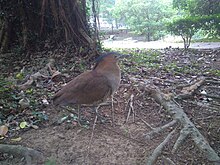
The great blue heron is a large wading bird in the heron family Ardeidae, common near the shores of open water and in wetlands over most of North and Central America, as well as far northwestern South America, the Caribbean and the Galápagos Islands. It is occasionally found in the Azores and is a rare vagrant to Europe. An all-white population found in south Florida and the Florida Keys is known as the great white heron. Debate exists about whether this represents a white color morph of the great blue heron, a subspecies of it, or an entirely separate species.

Herons are long-legged, long-necked, freshwater and coastal birds in the family Ardeidae, with 72 recognised species, some of which are referred to as egrets or bitterns rather than herons. Members of the genera Botaurus and Ixobrychus are referred to as bitterns, and, together with the zigzag heron, or zigzag bittern, in the monotypic genus Zebrilus, form a monophyletic group within the Ardeidae. Egrets do not form a biologically distinct group from herons, and tend to be named differently because they are mainly white or have decorative plumes in breeding plumage. Herons, by evolutionary adaptation, have long beaks.

The grey heron is a long-legged wading bird of the heron family, Ardeidae, native throughout temperate Europe and Asia, and also parts of Africa. It is resident in much of its range, but some populations from the more northern parts migrate southwards in autumn. A bird of wetland areas, it can be seen around lakes, rivers, ponds, marshes and on the sea coast. It feeds mostly on aquatic creatures which it catches after standing stationary beside or in the water, or stalking its prey through the shallows.

The great egret (Ardea alba), also known as the common egret, large egret, or great white egret or great white heron, is a large, widely distributed egret. The four subspecies are found in Asia, Africa, the Americas, and southern Europe. Recently it is also spreading to more northern areas of Europe. Distributed across most of the tropical and warmer temperate regions of the world, it builds tree nests in colonies close to water.
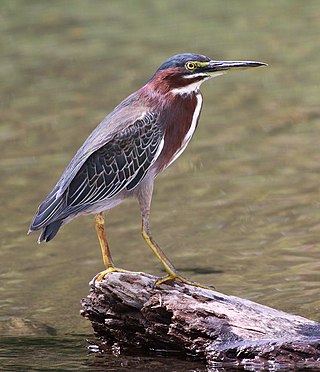
The green heron is a small heron of North and Central America. Butorides is from Middle English butor "bittern" and Ancient Greek -oides, "resembling", and virescens is Latin for "greenish".

The yellow-crowned night heron, is one of two species of night heron in genus Nyctanassa. Unlike the black-crowned night heron, which has a worldwide distribution, the yellow-crowned is restricted to the Americas. It is known as the bihoreau violacé in French and the pedrete corona clara or yaboa común in some Spanish-speaking countries.
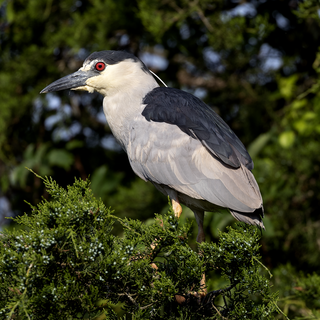
The black-crowned night-heron, or black-capped night-heron, commonly shortened to just night-heron in Eurasia, is a medium-sized heron found throughout a large part of the world, including parts of Europe, Asia, and North and South America. In Australasia it is replaced by the closely related nankeen night-heron, with which it has hybridized in the area of contact.
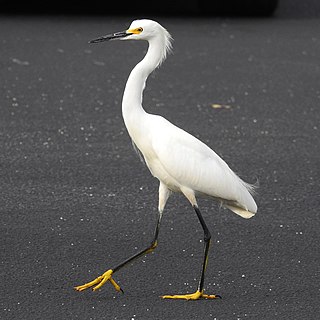
The snowy egret is a small white heron. The genus name comes from Provençal French for the little egret, aigrette, which is a diminutive of aigron, 'heron'. The species name thula is the Araucano term for the black-necked swan, applied to this species in error by Chilean naturalist Juan Ignacio Molina in 1782.

The citrine wagtail (Motacilla citreola) is a small songbird in the family Motacillidae.

The purple gallinule is a swamphen in the genus Porphyrio. It is in the order Gruiformes, meaning "crane-like", an order which also contains cranes, rails, and crakes. The purple gallinule is a rail species, placing it into the family Rallidae. It is also known locally as the yellow-legged gallinule. The specific name martinica denotes "of Martinique".

Anolis carolinensis or green anole is a tree-dwelling species of anole lizard native to the southeastern United States and introduced to islands in the Pacific and Caribbean. A small to medium-sized lizard, the green anole is a trunk-crown ecomorph and can change its color to several shades from brown to green.

The white-faced heron also known as the white-fronted heron, and incorrectly as the grey heron, or blue crane, is a common bird throughout most of Australasia, including New Guinea, the islands of Torres Strait, Indonesia, New Zealand, and all but the driest areas of Australia.

The black-headed ibis, also known as the Oriental white ibis, Indian white ibis, and black-necked ibis, is a species of wading bird of the ibis family Threskiornithidae which breeds in the South and Southeast Asia from India to the west and as far east as Japan. It is the only native ibis species in its range that has an overall white plumage with a black neck and head. The down-curved beak and legs are also black. Though often referred to as a wetland species, the black-headed ibis forages in a range of natural and man-made habitats. This species of ibis nests only during the rainy season.

The little blue heron is a small heron of the genus Egretta. It is a small, darkly colored heron with a two-toned bill. Juveniles are entirely white, bearing resemblance to the snowy egret. During the breeding season, adults develop different coloration on the head, legs, and feet.

The medium egret, median egret, smaller egret or intermediate egret, is a medium-sized heron. Some taxonomists put the species in the genus Egretta or Mesophoyx. It is a resident breeder in southern and eastern Asia.
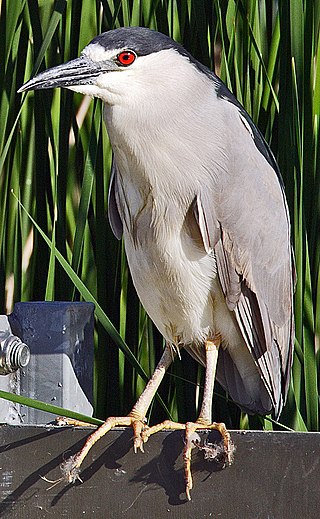
The night herons are medium-sized herons, 58–65 cm, in the genera Nycticorax, Nyctanassa, and Gorsachius. The genus name Nycticorax derives from the Greek for "night raven" and refers to the largely nocturnal feeding habits of this group of birds, and the croaking crow-like, almost like a barking sound, call of the best known species, the black-crowned night heron.

The Bonin white-eye or meguro (メグロ) is a small songbird endemic to the Bonin Islands of Japan. It is the only species in the genus Apalopteron. Its taxonomic affinities were a long-standing mystery and it has been placed with the bulbuls, babblers and more recently with the honeyeaters, during which it was known as the Bonin honeyeater. Since 1995 it is known to be a white-eye in the family Zosteropidae, that is closely related to the golden white-eye of the Marianas Islands.

The Japanese night heron is a species of night heron found in East Asia. It breeds in Japan, and winters in the Philippines and Indonesia. It is also seen in the spring and summer in Korea and the Russian Far East.

The fairy pitta is a small and brightly colored species of passerine bird in the family Pittidae. Its diet mainly consists of earthworms, spiders, insects, slugs, and snails. The fairy pitta breeds in East Asia and migrates south to winter in Southeast Asia. Due to various habitat and anthropogenic disruptions, such as deforestation, wildfire, hunting, trapping, and cage-bird trade, the fairy pitta is rare and the population is declining in most places. Listed on the Convention on International Trade in Endangered Species of Wild Fauna and Flora (CITES) Appendix II, this bird is classified as vulnerable on the IUCN Red List of Threatened Species.

The white-eared night heron is a species of heron in the family Ardeidae. It is found in southern China and northern Vietnam.. It is threatened by habitat loss and habitat fragmentation.




